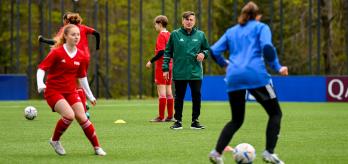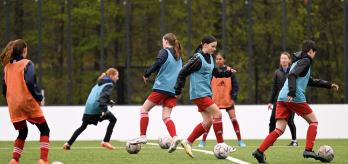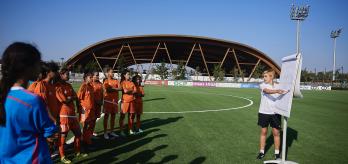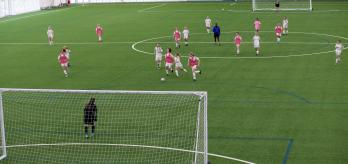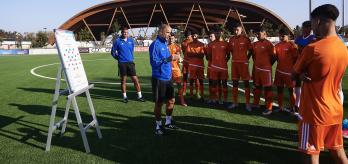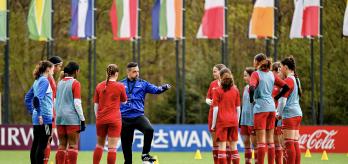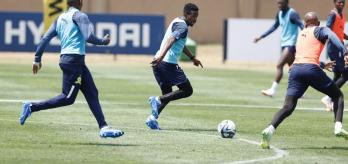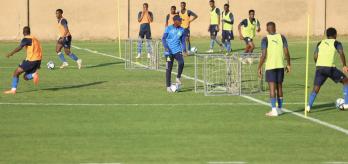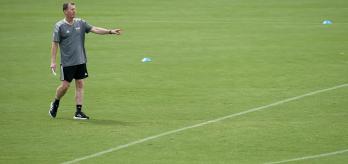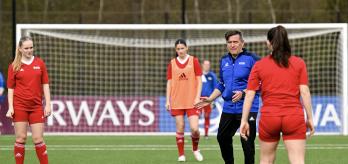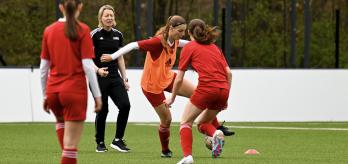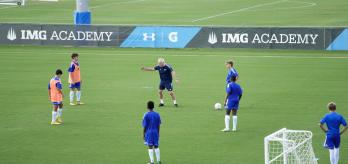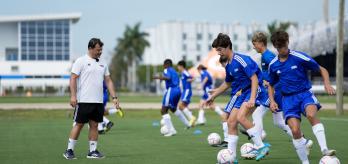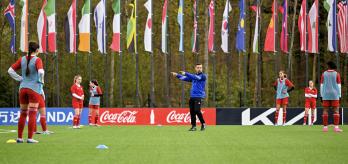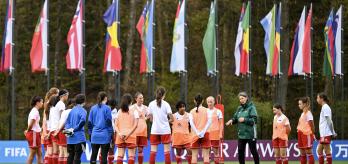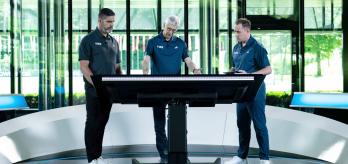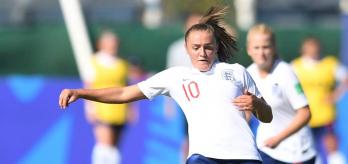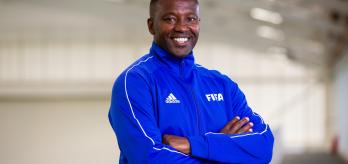In this session, Mamelodi Sundowns’ U21 Head Coach, Sinethemba Badela, takes his team through a series of exercises that work on creating overloads. Badela emphasises that trying to create 2v1 scenarios as quickly as possible will give his team a better chance of succeeding with their attack.
This session is based on a typical Mamelodi Sundowns Matchday -3 training session and starts with a warm-up focused on gradually increasing intensity and explosive movements. This is followed by a passing sequence, a small-sided transitional game, 1v1/2v1/2v2 scenarios and an 8v8 game with one team attacking three mini goals and the other one full-sized goal. The session ends with an 8v8 game with normal rules on a reduced pitch, designed to encourage the squad to put the skills they have developed into practice.
Session overview
Key points
-
Overload areas in attack by creating 2v1s or 3v2s as quickly as possible. This allows you to take defenders out of the game.
-
Adopt an explosive, aggressive approach and drive forward with the ball whenever possible. This will open up space for other players and put the opposition on the back foot.
-
Use overlaps and underlaps to penetrate the opposition’s defence and find ways to create chances.
-
Counter-press as soon as you lose the ball so that the opposition cannot build an attack and don’t have time to switch back to a defensive mindset.
-
Incisive, precise, firm passes are needed to cut through the opposition’s press and defensive lines.
Warm-up
The warm-up includes 3 phases and incorporates a variety of stretches or exercises designed to steadily activate the players for the upcoming exercises. The idea is to start at light intensity and gradually increase it so that players can perform at their peak levels and avoid injury or fatigue.
Phase 1
-
Players gather in a large circle.
-
The coach performs a series of stretching and limbering exercises.
-
The players copy the stretches that the coach performs.
-
The players should complete the stretches at low intensity
Phase 2
-
Set up 4 different stations in a circuit.
-
Each station must have different equipment to work with (balls, weights, poles)
-
Divide the players into groups and position them at each station.
-
The exercises consist of several stretches with weights, light movement with a ball and explosive body movements.
-
After a few minutes at each station, rotate the players to different stations of the circuit.
-
The intensity should be increased for this phase.
Phase 3
-
Mark out an area 15m in length.
-
If you have a large group of players, divide them into different lines.
-
The players must jog lightly from one end of the area to another.
-
The coach will give the players some exercises or stretches to perform as they jog.
-
Increase the intensity by introducing explosive movements and short sprints.
Part 1: Passing circuit with overlaps
This first exercise helps players to integrate overlapping runs within a passing sequence. The focus is on the timing of the overlap and the layoff, which are key to an effective overlapping move.
-
Mark out two 25x15m areas parallel to one another.
-
Position 2 poles in the centre of each area. Each pole must be 10m from the ends of the area.
-
Split the players into 2 groups of 8.
-
Position a player at each of the poles (Points C and D).
-
At the starting end, position 2 players each at Points A and B.
-
At the opposite end, position 1 player each at Point E and F.
-
The ball starts with 1 of the 2 players positioned at Point A.
-
Player A passes into Player C.
-
At the same time, Player B moves forward.
-
Player C lays the ball off to Player B.
-
Player A must continue to run forward.
-
Player B passes into Player D.
-
Player D lays the ball off to Player A, who should have timed their run to receive the ball at this point.
-
Player A passes to Player E.
-
Repeat the sequence in the opposite direction with Players E and F.
-
Players A and B follow their passes and wait at Points E and F.
-
Player A passes into Player D.
-
Player D lays off to Player C.
-
Player B should have timed their run to be alongside Player C.
-
Player C passes to Player B.
-
Player B passes into Player F and follows their pass to Point F.
-
Meanwhile, Player A should have run to Point E.
-
Repeat the sequence in the opposite direction with Players E and F.
-
Player A passes into Player C.
-
Players A and B simultaneously cross over to the opposite side.
-
Player C lays the ball off for Player B.
-
Player B passes into Player D.
-
Player D lays the ball off for Player A, who should have arrived on the right side of the circuit to receive.
-
Player A passes the ball into Player F and follows their pass to Point F.
-
Player B runs to Point E.
-
Repeat the sequence in the opposite direction with Players E and F.
-
Player A passes into Player C.
-
Players A and B simultaneously cross over to the opposite side.
-
Player C lays the ball off for Player B to run onto.
-
Player B passes into Player D.
-
Once they reach the first pole, Players A and B simultaneously cross back over to their original sides.
-
Player D lays the ball off into Player A’s run.
-
Player A passes into Player E. At the same time, Player B continues their overlapping run on the other side.
-
Players A and B run to Points E and F respectively.
-
Repeat the sequence in the opposite direction with Players E and F.
-
Firm passes and close touches increase the efficiency and flow of the sequence.
-
By opening their bodies and moving off the poles, players can receive the ball in motion and lay it off effectively.
-
When making overlaps, arc your run. This helps to make sure the run is well timed and the ball is received at the right moment.
-
A quality layoff allows receiving players to execute final passes with conviction and speed.
-
When performing overlaps, accelerate explosively to take full advantage of the open space.
Part 2: 4v2 small-sided game
This small-sided game has been designed to help players attack incisively and make fast decisions based on the routes they have toward goal. Players must transition quickly and attack space to throw defenders off balance.
-
Mark out two 10x10m zones, 5m apart.
-
You will need 6 mini-goals in total.
-
Position one mini-goal at the end of each zone. They should be facing each other.
-
Position a mini-goal on both sides of each zone and angle them inwards at 45 degrees.
-
Split the group into 2 teams of 4.
-
4 Blue players start in one zone, along with 2 Orange players.
-
Position 2 Orange players in the other zone.
-
The Blue team starts in possession in the “possession zone.”
-
The 2 Orange players must try to win the ball.
-
The Blue team must make 10 consecutive passes. They get 2 attempts to do this before possession transfers to the other team.
-
Once Blue make 10 consecutive passes, 3 Blue players enter the “attacking zone” and play a 3v2 against the other 2 Orange players already waiting in that zone.
-
While this is going on, 1 Blue player must stay in the possession zone; they can only retrieve the ball and pass it back into the attacking zone.
-
The Blue team must try to score in any of the 3 mini-goals.
-
If the Blue team scores, they restart the 4v2 inside the zone where they scored the goal.
-
If the Blue team fail to score, the Orange team are given the ball, and they have the 4v2 advantage.
-
If the Orange team win the ball before the blue team makes 10 passes, they must transfer to the other zone and try to score in the mini-goals.
-
Identify which mini-goal is easiest to score in and play accordingly; if the defending team have 2 mini-goals covered, try to score in the open one.
-
Counter-press as soon as you lose control of the ball so that you can salvage the situation and retain the chance to score.
-
Be aggressive and apply attacking principles when switching into the attacking phase; this will help to unbalance the opposition.
-
Use lots of movement off the ball, such as overlaps and underlaps, to open routes to the mini-goals.
Part 3: 1v1s, 2v1s and 2v2s
This exercise gives players the chance to work on their 1v1 skills in attacking and defensive situations. The use of off-the-ball runs, such as overlaps and underlaps, will help to distract defenders, while driving at opposing players with the ball can cause disruption in their defence.
-
Mark out two adjoining 20x15m areas.
-
Position two mini-goals each at the ends of both areas, one angled to the left, and one to the right (so you will need a total of 8 mini-goals).
-
Keep the same groups as in Part 2.
-
In area 1, position 1 Blue player.
-
In area 2, position 1 Orange player.
-
Next, position 3 Blue players and 2 Orange players on the right of the line between the two adjoining areas. Then position 3 Orange players and 2 Blue players on the left of the same line.
-
Position 2 Blue players behind the mini-goals in area 1.
-
Position 2 Orange players behind the mini-goals in area 2.
-
The Blue team start from the right and the Orange team start from the left.
-
The Blue team must pass the ball into their team-mate inside area 1.
-
The Orange team must pass the ball into their team-mate inside area 2.
-
Once these players receive the ball, they must pass it to their team-mate on the other side.
-
As soon as the player on the opposite side receives the ball, they must attack the mini-goals inside the area occupied by the opposition player (this is a 1v1 situation).
-
If they score or the ball goes out of play, the sequence restarts.
-
If the defending player wins the ball, they must try to score in the central mini-goals positioned inside the same area.
-
Players must rotate positions anti-clockwise.
Variation 1
-
The player who makes the first pass in the sequence joins their team-mate to attack in a 2v1 scenario.
Variation 2
-
The player waiting behind the mini-goals joins their team-mate to defend the mini-goals in a 2v2 scenario.
-
If the attacking team lose the ball, they must counter-press as quickly as possible to prevent the defenders from scoring.
-
Players on the ball should drive at the opposition, while their teammates should make overlaps to make it harder for the opposition to make decisions.
-
Make arced runs around the back of your team-mates to confuse the defenders and create space on either side.
Part 4: 8v8 game on reduced pitch
This 8v8 game focuses on creating overloads in all areas of the attack, and taking advantage of them to create chances. The players must drive with the ball when they can and use overlaps and underlaps to exploit the overload.
-
Mark out a 47x40m field.
-
Position a full-size goal at one end of the pitch, guarded by a goalkeeper.
-
At the other end, position 3 mini-goals.
-
Play an 8v8 training match.
-
The Blue team start with the ball and attack the 3 mini-goals.
-
The Orange team attacks the full-size goal.
-
If the Blue team scores, the ball restarts with the goalkeeper.
-
If the Orange team wins the ball and scores, play shifts to the area behind the goal and the teams swap roles.
-
Exploit the overload using quick overlaps and underlaps. This allows the ball to be worked in behind more effectively.
-
As soon as you lose the ball, react quickly and counter-press to regain possession and take advantage of the overload you will still have.
-
Create 2v1 scenarios whenever possible to take defenders out of the game and create scoring opportunities.
Part 5: 8v8 game
In this final exercise, players must try to put into practice all the elements that they worked on in the previous exercises.
-
Mark out a 70x40m field.
-
Use 2 full-size goals, each guarded by a goalkeeper.
-
Play an 8v8 game.
-
The ball starts with one of the goalkeepers.
-
Any time the ball goes out of play, restart with a goalkeeper.
-
Play 2 sequences of 5 minutes.
-
Whenever there is space to move forward, players must drive at the opposition to create disruption and make more space.
-
Penetrate the opposition’s defence by making overlaps and underlaps, thus creating space for crosses and cutbacks.
-
If the team in possession loses the ball, they must try to recover it immediately by pressing the ball-carrier and closing down passing lanes.
-
Encourage players to play quickly rather than use a slow build-up.
Reflection
In the video below, Sinethemba Badela explains how he structures his training week and reflects on the session on creating and exploiting overloads, highlighting the main attacking and defending principles he wanted to focus on.
















